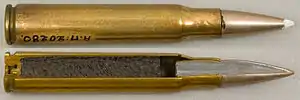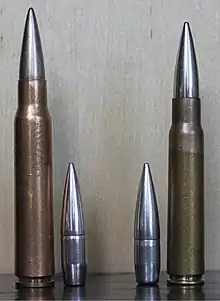8×63mm patron m/32
The 8×63mm patron m/32 was a bottlenecked centrefire cartridge with a slightly (0.25 mm (0.0098 in)) rebated rim for Swedish heavy and medium machine guns. It was used from 1932 to the finalisation of the re-chambering process of these machine guns to 7.62×51mm NATO in 1975.
| 8×63mm | ||||||||
|---|---|---|---|---|---|---|---|---|
 Two 8×63mm patron m/32 military cartridges | ||||||||
| Type | Rifle | |||||||
| Place of origin | Sweden | |||||||
| Service history | ||||||||
| In service | 1932–1975 | |||||||
| Used by | Sweden | |||||||
| Wars | UN intervention in Kongo 1960-1964 | |||||||
| Production history | ||||||||
| Designer | Kungliga Armétygförvaltningen (KAF) AktieBolaget Bofors | |||||||
| Designed | late 1920s, early 1930s | |||||||
| Manufacturer | AB Bofors | |||||||
| Specifications | ||||||||
| Case type | Rimless, bottleneck | |||||||
| Bullet diameter | 8.20 mm (0.323 in) | |||||||
| Neck diameter | 9.10 mm (0.358 in) | |||||||
| Shoulder diameter | 11.51 mm (0.453 in) | |||||||
| Base diameter | 12.43 mm (0.489 in) | |||||||
| Rim diameter | 12.18 mm (0.480 in) | |||||||
| Rim thickness | 1.42 mm (0.056 in) | |||||||
| Case length | 62.81 mm (2.473 in) | |||||||
| Overall length | 84.62 mm (3.331 in) | |||||||
| Primer type | Large rifle | |||||||
| Ballistic performance | ||||||||
| ||||||||
| Test barrel length: 609 mm (24 in) Source(s): [1] | ||||||||
History

Right; 7.92×57mm Mauser cartridge
and 11.55 g (178.2 gr) S.m.E. (mild steel cored) 8 mm S bore bullet
Given the experiences of the devastating effect of small arms fire in Russo-Japanese War and the Great War, as well as a revolution in terminal ballistic calculations, calibre-related concerns occupied a lot of attention worldwide in military establishments.[2] Sweden was no exception, and series of trials in calibres 6mm-12mm were conducted until the late 1920s.[2] At this time, the standard service cartridge in Swedish use was the 6.5×55mm Swedish skarp patron m/94 projektil m/94 (live cartridge m/94 projectile m/94) service ammunition loaded with a 10.1 grams (156 gr) long round-nosed m/94 (B-projectile) bullet. After study-travels by överstelöjtnant de Laval along with kaptenerna Nygren och Holmgren, mainly to Germany and the Netherlands in October 1930, Royal Swedish Army Materiel Administration (Kungliga Armétygförvaltningen (KAF) appointed a commission that conducted a series of tests with calibres 6,5 mm to 7,2 – 7,5 – 7,9 mm, and bullet weights between 8.4 grams and 17.0 grams, with the intention to either recommend a new calibre for the kulspruta m14-29 or retain the 6.5×55mm but with a new boattail bullet (m/41), as the old blunt nosed projectile m/94 had inferior ballistics.[2] The commission fond that at ranges below 2,400 m (2,625 yd), no recommendation could be given without indepth analysis of intended tasks within the tactical doctrine.[2] Past this, the 14.2 gram bullet in calibre 7.9mm performed superior in precision and penetration while not causing excessive barrel wear as well as fulfilling the requirement of 20 kilogram-metres impact force up to a range of 3,600 m (3,937 yd).[2] Based on this, KAF tasked AB Bofors to develop and manufacture manufacture the larger rifle cartridge to meet these needs.[2]
Design
The patron m/32 round had the same overall length as the .30-06 Springfield cartridge, which allowed it to fit in the standard Browning receiver, but used a larger diameter case and like the 6.5×55mm had an uncommon 12.2 mm (0.48 in) diameter bolt face. Compared to the 1928 pattern .30-06 Springfield M1 Ball the 8×63mm patron m/32 was loaded with 8.20 mm (0.323 in) S bore 14.2 g (219.1 gr) bullets and had more muzzle energy. The 8×63mm patron m/32 had a muzzle velocity of 760 m/s (2,493 ft/s) and an operating pressure of 330 MPa (47,862 psi).
The patron m/32's aerodynamically refined boat tailed spitzer bullet had an effective range of approximately 3,600 m (3,937 yd) on which the impact energy was 196 J (145 ft⋅lbf), and a maximum range of approximately 5,500 m (6,015 yd) when fired from a kulspruta m/36.[3] Reverse engineering the trajectory from the previous sentence indicates a ballistic coefficient (G1 BC) of approximately 0.63. Available with armour piercing bullets, patron m/32 was used in the UN-forces' KP-bil during the Congo-crisis against the separatists' armoured cars.
The 8×63mm patron m/32 cartridge was used in the following machine guns:[4]
The 8×63mm patron m/32 was also used in the gevär / pansarvärnsgevär m/40[2] bolt-action rifle, Karabiner 98k's re-chambered in Sweden for the patron m/32. Originally purchased (pvg m/39 in 8×57 IS) as a stop-gap anti-tank rifle and later issued to the machine gun troops so their rifles would fire the same round as their machine guns. Besides the rechambering a muzzle brake was added necessitated by the additional recoil produced by the more powerful 8×63mm patron m/32 cartridge.
Military ammunition
| Designation | Type | Weights (gram) | Propellant type | Projectile material(s) | Muzzle velocity V0 or V25 | Armor penetration | Burning range | Remarks | |||
|---|---|---|---|---|---|---|---|---|---|---|---|
| Cartridge | Projectile | Propellant | |||||||||
| 8 mm sk ptr m/32 | FMJ | 32,1 | 14,13 | 3,6 | Kspkr 1/0,55 | Lead core, Nickel jacket | 750 m/s (V25) | None | Standard Ball. | ||
| 8 mm sk ptr m/32
"For peacetime only" |
FMJ | 32,17 | 14,2 | 3,6 | Kspkr 1/0,55 | Lead core, Nickel jacket | 760 m/s | Blue tip | Ammunition of inferior quality.
Used in peacetime. | ||
| 8 mm sk ptr m/32
"Not for machine guns" |
FMJ | 32,17 | 14,2 | 3,6 | Kspkr 1/0,55 | Lead core, Nickel jacket | 760 m/s | Green tip | Same as above but has green marking.
This means "Not for machine guns" | ||
| 8 mm sk ptr m/32 pprj m/39 | AP | 29,7 | 11,8 | 3,6 | Kspkr 1/0,55 pbr | 3,2 g steel core | 780-810 m/s | ~10 mm at 50 m | Black tip | Ordinary armor-piercing cartridge. | |
| 8 mm sk ptr m/32 pprj m/40
or 8 mm pbr ptr m/32-40 |
AP | 31,14 | 15,7 | 3,6 | Kspkr 1/0,55 pbr | Tungsten core | 725 m/s | ~20 mm at 0 m | Top half black | Tungsten-cored ammunition.
Only used in machine guns. | |
| 8 mm sk ptr m/32 slprj m/39 | Tracer | 28,9 | 11,01 | 3,6 | Kspkr 1/0,55 | Projectile contains phosphorus, no boat tail | 780-824 m/s | red 100-800 m | Red tip | First marking of slprj m/39 | |
| White tip | Second marking of slprj m/39. | ||||||||||
| 8 mm sk ptr m/32 slprj m/39
"with a different spark plug" |
Tracer | 28,9 | 11,01 | 3,6 | Kspkr 1/0,55 | Projectile contains phosphorus, no boat tail | 780-824 m/s | Red 100-800 m | Red tip | The spark plug is dark gray and not magnetic.
The spark plug is probably produced in Germany. | |
| 8 mm sk ptr m/32 brandprj m/40 | Incendiary | 11,55 | Phosphorus and lead | Yellow tip | Incendiary ammunition from Hungary. Trubbkula. | ||||||
| 8 mm sk ptr m/32 brandprj m/41 | Incendiary/AP | 27,7 | 9,8-9.9 | 3,6 | Kspkr 1/0,55 pbr | Has an internal steel core surrounderd by fuel | 835-930 m/s | Orange tip | The ammunition is primarily for aircraft and is a semi-armor piercing projectile | ||
| 8 mm Tysk B patron
"Observation cartridge" |
High-explosive incendiary | Bottom halve black | German B bullet loaded in a Swedish 8×63 cartridge. | ||||||||
| 8 mm sk blindptr m/32 | Dummy | None | Early marking. | ||||||||
| 8 mm sk blindptr m/32 | Dummy | Green tip | Late marking. | ||||||||
The operating pressures of the various ammunition types varied between 330–350 MPa (47,862–50,763 psi).
References
External links
| Wikimedia Commons has media related to 8 x 63 mm m/32. |
- 8x63 M32 Bofors
- HISTORIC MACHINE GUN CARTRIDGES by Anthony G Williams
- 8x63 Swedish / 8x63 Bofors (in Russian)
- 8x63 Swedish Bofors / 8 mm Bofors / 8x63 Swedish For MG Mod.1932 / 8mm SK PTR M-32 / 8mm Sueco / 8x63 / SAA 4540 / XCR 08 063 BGC 010 (In Spanish)
- The Swedish military ammunition site
- Ammunitionsregister för armén, 1960
- instruction drawings of 8×63mm patron m/32 ammunition